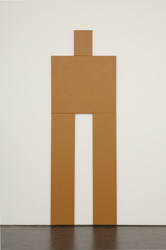Born 1975 in Old Orchard Beach, Maine; lives in New York, New York
At first glance, Joe Bradley’s abstract, monochromatic canvases look like experiments in Minimalism; longer viewing, however, reveals surprising levels of figuration and what Bradley calls an “intentional shoddiness” that points to a dissatisfaction with the narrative of twentieth-century painting. His depictions of people, animals, places, and objects are visually distilled rectangles of color and blocky forms that, hung in sets on the wall, communicate an overall sense of theater and movement. Described by the artist as expressively “pathetic” takes on heroic, large-scale Color Field works, they have the primitive feel of ancient totemic sculptures. At the same time, subtle color variations and surface texturing on the flimsy, store-bought canvases belie the fetishized perfection the paintings allude to. By grouping his works as installations, Bradley injects additional character into each piece, letting them interact as families of energized entities.
Bradley’s works refer to multiple modern art movements while exposing the absurdities of the critical systems they borrow from. Though his paintings draw visually from Ellsworth Kelly, Joel Shapiro, and Barry Le Va, the humorous narratives they create lend them an enlightened Pop sensibility: Animal (2007) consists of four variously sized, rectangular brown canvases arranged to look like the head, torso, and legs of a 9-foot-tall creature rearing up before the viewer. The four canvases that make up The Thing (2007) are placed in the same configuration as Animal, painted a vivid orange that suggests the eponymous comic-book character. In a 2007 solo show at Peres Projects Berlin, these two pieces were shown in separate rooms to emphasize their individuality. Installed diagonally across from The Thing in the Berlin exhibition, Cavalry (2007) is a sevenpart acrylic painting composed of a yellow horizontal rectangle and vertical blue and red rectangles positioned to connote the heads and legs of two soldiers the artist envisions as “marching to the rescue.” Together the paintings engaged in a dialogue that anthropomorphized the works to challenge definitions of abstract painting as a philosophically hard-line, self-referential process.
While operating in a lightheartedly slapdash mode, Bradley’s paintings also reflect a thoughtful attention to the study of color and the visual range achievable through presenting colors alone or juxtaposing them in infinite combinations. In particular, his work harks back to Josef Albers’s color theories about the physical versus psychic effects of color. Though his installations have a certain geometric precision, Bradley hopes his paintings’ visual economy will give the viewer a psychological charge that is as oddball as it is formally engineered. TRINIE DALTON
Joe Bradley, Animal, 2007. Synthetic polymer on canvas, four parts, 108 1/2 x 36 in. (275.6 x 91.4 cm) overall. Courtesy the artist, Peres Projects, Los Angeles, Berlin and Private collection
























